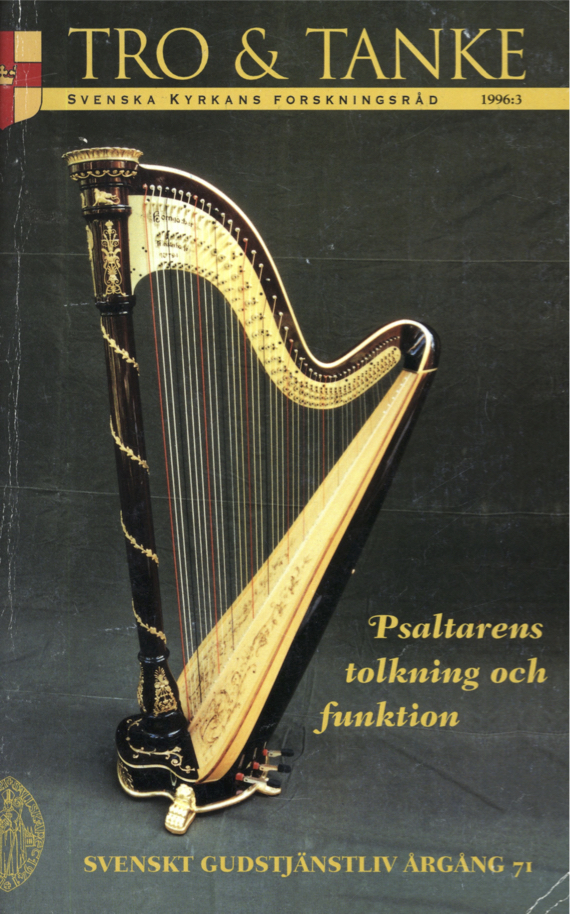Olika sätt att sjunga Psaltaren
Abstract
The purpose of this article is to focus on the Psalms as songs with the different musical forms and backgrounds which they have had up to the present.
In the Church of Sweden, the Psalms are more often read than sung. Of course, this does not mean that the Psalter is being used wrongly. The important thing is to use the Psalms as texts and as a book of prayer with a divine message.
The Swedish Divine Office with its musical accompaniment has been published since the 1940’s. The Divine Offices have not been used much in the parishes of the Church of Sweden. The official church has not taken responsibility for the Divine Office, in contrast to the Anglican Communion, for example. However, during more recent decades, one can find more consciousness of the nature of the Psalter as a songbook.
This article is an attempt to give an outline of the Psalter as a book of songs from the days of the Israelite temples to modern time.
The organizer of the temple music was King David. He gave great importance to the jobs of the choir-members and the musicians. The different forms of the chanting singing (cantillation) of the Psalms during the time of the temples (100 BC-70 AD) were:
— chanting the Psalms by a soloist, perhaps with a harp-instrument
— chanting the Psalms by the choir with the temple orchestra
— chanting the Psalms by the choir with a refrain sung by the people.
The refrain can often be found in the same Psalm or consist of a Hallelujah.
There is a discussion among the scholars as to whether the Jews used the Psalms in the synagogue. There is no certain documentation to be found.
Jesus and the first Church used the Psalms and sung them in the Jewish manner not using instruments.
Probably the Church preserved a good deal of the Jewish chanting of the Psalms through the ages. In the time of Augustine, the liturgical song of the church developed towards a more artistic and complicated song, supposedly a stage of development of the music which was later to be called ”Gregorian”.
The liturgical song of the Roman Church (called ”Gregorian chant”) in Mass and Divine Office was born of the holy words of the Psalter (and other texts). The psalmody was a punctuating kind of music, always respecting the syntax of the Latin language.
The liturgical music of the Byzantine/Orthodox Church was also derived from Jewish music but the development of Byzantine music was different. It started in the 4th century when the Roman Catholic Church proclaimed Latin as the official language. The Psalter was sung in the Divine Liturgy of St. John Chrysostomn as well as in the Divine Office.
There is a great difference between Greek Church music and Russian Church music. The Greeks have preserved more of the primitive manner of singing. The Russians started to use choir-settings of the liturgical melodies in the 16th century.
The historical part of the article is closed with a summary of classical Psalter music through the ages. The chapter is called ”From de Prez to Pärt”. The names of the different composers are to be found in the article.
The name of the last chapter is ”Different Ways of Singing the Psalter in the Congregation”. Different forms are presented, and especially those found in the Swedish Church:
1. Gregorian manner. We have two ways of singing Gregorian in Swedish, namely
a) The ”Laurentius Petri Sällskapet” (The Laurentius Petri Society, LPS) endeavours to adapt the Swedish language to the original Latin melodies in manuscripts from the Middle Ages. Professor Ragnar Holte is responsible for the LPS music.
b) The Roman Catholic scholar and organist Anders Ekenberg endeavours to compose in Gregorian style using melodic formulas from the old medieval repertoire. Anders Ekenberg is the music editor of the new Swedish Roman Catholic Divine Book of Office (Kyrkans dagliga bön).
2. Responsorial Psalms (with refrains for the congregation) in the Hymnal of the Church of Sweden (1986). The inspiration for this kind of psalmody came from the Roman Catholic Church (Gelineau and others) after the Vatican II.
3. Taizé-psalmody. We have four song-books, the first one published in 1983.
4. Anglican chant in Swedish, introduced to the Church of Sweden in 1975.
5. Orthodox psalmody from the monastery of Chevetogne which has been adapted to Swedish texts.
6. Metrical psalms. We have a small repertoire in our hymn-book. In earlier editions, we had many more.
7. Short songs of Praise; strongly influenced by the Jesus movement and the charismatic movement. We have some in our Hymnal, and still more in special song booklets. 8. Choir setting motets, set to a Psalm or verses from the Psalms by many composers; please see list.
Downloads
Publicerad
Nummer
Sektion
Licens
© författarna, Laurentius Petri Sällskapet för svenskt gudstjänstliv samt Artos & Norma bokförlag. Det är tillåtet att kopiera och använda material ur Svenskt Gudstjänstliv för forskningsändamål om källan anges. För övriga ändamål kontakta respektive artikelförfattare samt förlaget. Särskilda restriktioner kan gälla för bildmaterial.


